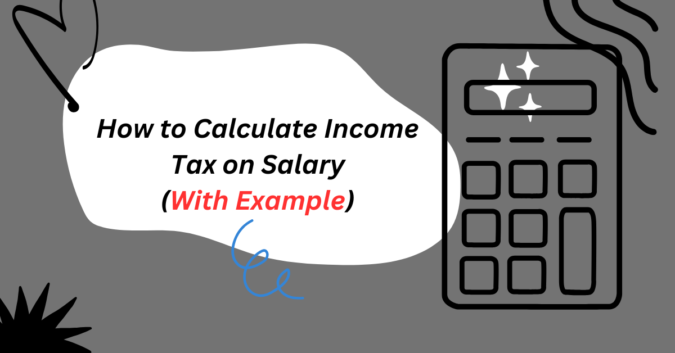Want to know how to calculate income tax on salary with example? Income tax calculation can seem complex, but with a clear understanding of the process, it becomes much easier.
Whether you are filing for the first time or just want to understand the new tax regime, this guide will help you calculate your income tax on salary in India.
We’ll cover the basics of tax slabs, deductions, and exemptions, with an example to make it clear.
Step-by-Step Guide to Calculate Income Tax on Salary in India
Step 1: Know Your Gross Salary
Your gross salary includes everything you earn, such as:
- Basic Salary
- House Rent Allowance (HRA)
- Special Allowances
- Bonuses or commissions
- Any other benefits like leave encashment
Step 2: Subtract Deductions and Apply Exemptions
Next, you apply deductions to reduce your taxable income. Common deductions include:
- Standard Deduction of ₹50,000
- Section 80C for investments in PPF, ELSS, or life insurance (up to ₹1.5 lakh)
- HRA Exemption for those living in rented houses
- Section 80D for health insurance premiums
Step 3: Apply the New Tax Slabs
For FY 2025-26, the income tax slabs for individual taxpayers under the new tax regime are as follows:
| Income Range (₹) | Tax Rate (%) |
|---|---|
| Up to ₹4,00,000 | Nil |
| ₹4,00,001 to ₹8,00,000 | 5% |
| ₹8,00,001 to ₹12,00,000 | 10% |
| ₹12,00,001 to ₹16,00,000 | 15% |
| ₹16,00,001 to ₹20,00,000 | 20% |
| ₹20,00,001 to ₹24,00,000 | 25% |
| Above ₹24,00,000 | 30% |
Step 4: Calculate Tax
Once your taxable income is calculated, apply the appropriate tax rates based on the tax slabs. Let’s walk through an example to understand this process.
Example:
Scenario:
- Gross Salary: ₹15,00,000
- Deductions: ₹1,50,000 (including ₹1.5 lakh under Section 80C)
- Taxable Income: ₹15,00,000 – ₹1,50,000 = ₹13,50,000
Tax Calculation:
- Up to ₹4,00,000: No tax
- ₹4,00,001 to ₹8,00,000 (₹4,00,000): 5% of ₹4,00,000 = ₹20,000
- ₹8,00,001 to ₹12,00,000 (₹4,00,000): 10% of ₹4,00,000 = ₹40,000
- ₹12,00,001 to ₹13,50,000 (₹1,50,000): 15% of ₹1,50,000 = ₹22,500
Total Tax Payable: ₹20,000 + ₹40,000 + ₹22,500 = ₹82,500
Step 5: Consider Any Tax Rebates
If your income is below ₹5 lakh, you might be eligible for a rebate under Section 87A, which can reduce your tax liability by up to ₹12,500.
However, this rebate is not applicable in our example as the taxable income exceeds ₹5 lakh.
Step 6: Apply TDS or Advance Tax
If your employer has already deducted tax at source (TDS) or you have paid advance tax, subtract these amounts from your calculated tax liability.
Wrapping Up
Calculating your income tax on salary is simple once you understand the tax slabs and available deductions.
However, if you’ve recently received a salary hike, you might want to assess how it impacts your tax obligations.
A Salary Hike Calculator can help you quickly estimate the difference in tax liability after your raise. It’s a great tool to plan your finances effectively and ensure you’re aware of any additional tax payments.

